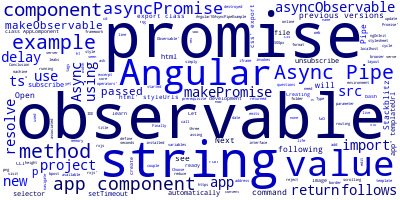Angular 10 Async Pipe with Observable and Promise Examples

In this example, we'll learn how to use the Async Pipe with observables and promises in Angular 10 and previous versions.
As a prerequisite, you need to have Angular CLI v10 installed on your development machine.
You can also use the online Stackblitz IDE if you don't have a development environment ready yet.
Creating a New Angular 10 Project
Let's get started with a new project. Go to a new command-line interface and run the following command to create a new project:
$ ng new Angular10AsyncPipeExample
The CLI will ask you a couple of questions — If Would you like to add Angular routing? Type y for Yes and Which stylesheet format would you like to use? Choose CSS.
Next, go to you project’s folder and run the server using the following commands:
$ cd Angular10AsyncPipeExample
$ ng serve
Use your web browser and visit the http://localhost:4200/ address to see your app running.
Open your web browser and navigate to the http://localhost:4200/ address to see your app running.
What is Async Pipe in Angular?
Async is an Angular pipe is that's used to automatically subscribe and unsubscribe from an observable or promise (invokes the then method) in templates. When the associated component is destroyed, it automatically unsubscribes from observables to reduce memory leaks.
The Async Pipe is available on Angular 10 and previous versions of the framework.
Angular 10 Async Pipe Example with Observable and Promise
Let's now see an example of using the async pipe with both an observable and promise.
Open the src/app/app.component.ts file and add the following imports:
import { Component } from '@angular/core';
import { Observable, of } from 'rxjs';
import { delay } from 'rxjs/operators';
Next, define two asyncPromise and asyncObservable variables as follows:
@Component({
selector: 'my-app',
templateUrl: './app.component.html',
styleUrls: ['./app.component.css']
})
export class AppComponent {
asyncPromise: Promise<string>;
asyncObservable: Observable<string>;
// [...]
}
asyncPromise is a promise that should return a string value and asyncObservable is an observable that should return string values.
Next, we define two methods for creating a promise from a string value and an observable from a string value as follows:
@Component({
selector: 'my-app',
templateUrl: './app.component.html',
styleUrls: ['./app.component.css']
})
export class AppComponent {
asyncPromise: Promise<string>;
asyncObservable: Observable<string>;
// [...]
makePromise(value: string): Promise<string> {
return new Promise((resolve, reject) => {
setTimeout(() => resolve(value), 3000);
})
}
makeObservable(value: string): Observable<string> {
return of(value).pipe(delay(3000));
}
}
For the promise, we simply resolve with the string passed as a parameter to the component's method after three seconds have passed using the setTimeout method.
For the observable, we create an observable, that emits the string value passed as a parameter to the component's method after three seconds have passed, using the of and delay methods.
Finally, we call the makePromise() and makeObservable() methods and we assing the returned promise and observable to the asyncPromise and asyncObservable variables in the ngOnInit life-cycle method of the component as follows:
@Component({
selector: 'my-app',
templateUrl: './app.component.html',
styleUrls: ['./app.component.css']
})
export class AppComponent {
asyncPromise: Promise<string>;
asyncObservable: Observable<string>;
ngOnInit() {
this.asyncPromise = this.makePromise('Async Promise');
this.asyncObservable = this.makeObservable('Async Observable');
}
makePromise(value: string): Promise<string> {
return new Promise((resolve, reject) => {
setTimeout(() => resolve(value), 3000);
})
}
makeObservable(value: string): Observable<string> {
return of(value).pipe(delay(3000));
}
}
Now that we have the promise and observable ready, we can use the async pipe in the component's template and subscribe to them.
Open the src/app/app.component.html file and update it as follows:
<h1>
Angular 10 Async Pipe with Observable and Promise Example
</h1>
<p>
</p>
<p>
</p>
The async pipe will call the then method of the promise and will subscribe and unsubscribe from the observable automatically.
This the Stackblitz live example:
Conclusion
We have seen how to use the async pipe with promises and observables in Angular 10 and previous versions.
-
Date:








